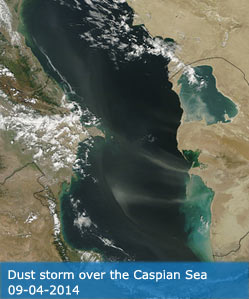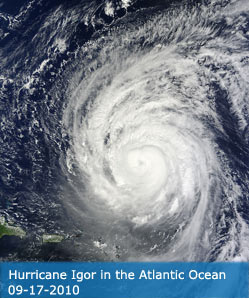Images
February 3, 2020 - Pink Lakes in Tunisia
Tweet
Several saline lakes dot the arid landscape of Tunisia. In summer, hot temperatures drive moisture from the lakes, sometimes drying them out almost entirely. Evaporation leaves behind a crust of salt and minerals, creating a “salt pan” that can be seen from space as a highly reflective white area surrounded by tan dry land.
Because these lakes have little or no inflow from rivers or streams, they remain dry until rains start to fall. Graced with enough precipitation, water fills the basin, minerals begin to dissolve, and a flush of life comes to the salt pans. Many of these lakes become an important wintering and breeding ground for birds such as the American Flamingo and Common Crane. In addition, the highly-saline waters allow for the growth of various types of algae and salt-loving bacteria, some of which can turn the waters pink as they grow. These colors are so startling that the Tunisian Desert has become quite famous for its pink lakes.
On January 29, 2020, the Moderate Resolution Imaging Spectroradiometer (MODIS) on board NASA’s Aqua satellite acquired a true-color image of three of the pink lakes of Tunisia. The largest is Sebkhet de Sidi El Hani, a favorite breeding area of American Flamingo. To the east and near the coast is the nearly-round Sebkha Of Moknine. Inland and in the south is an elongated dark pink lake, the Sebkhet El Rharra.
Thanks to the NASA Worldview app, it is possible to view the same area on previous days, enabling the ability to compare the same area in the dry season, when the salt crust on these lakes predominated the landscape. To take a look at the roll-over comparison between these lakes on January 29, 2020 and June 12, 2019, click
HERE
The NASA Worldview app provides a satellite's perspective of the planet as it looks today and as it has in the past. Worldview is part of NASA’s Earth Observing System Data and Information System. EOSDIS makes the agency's large repository of data accessible and freely available to the public.
Image Facts
Satellite:
Aqua
Date Acquired: 1/29/2020
Resolutions:
1km (137.4 KB), 500m (358.3 KB), 250m (683 KB)
Bands Used: 1,4,3
Image Credit:
MODIS Land Rapid Response Team, NASA GSFC
Tweet
Several saline lakes dot the arid landscape of Tunisia. In summer, hot temperatures drive moisture from the lakes, sometimes drying them out almost entirely. Evaporation leaves behind a crust of salt and minerals, creating a “salt pan” that can be seen from space as a highly reflective white area surrounded by tan dry land.
Because these lakes have little or no inflow from rivers or streams, they remain dry until rains start to fall. Graced with enough precipitation, water fills the basin, minerals begin to dissolve, and a flush of life comes to the salt pans. Many of these lakes become an important wintering and breeding ground for birds such as the American Flamingo and Common Crane. In addition, the highly-saline waters allow for the growth of various types of algae and salt-loving bacteria, some of which can turn the waters pink as they grow. These colors are so startling that the Tunisian Desert has become quite famous for its pink lakes.
On January 29, 2020, the Moderate Resolution Imaging Spectroradiometer (MODIS) on board NASA’s Aqua satellite acquired a true-color image of three of the pink lakes of Tunisia. The largest is Sebkhet de Sidi El Hani, a favorite breeding area of American Flamingo. To the east and near the coast is the nearly-round Sebkha Of Moknine. Inland and in the south is an elongated dark pink lake, the Sebkhet El Rharra.
Thanks to the NASA Worldview app, it is possible to view the same area on previous days, enabling the ability to compare the same area in the dry season, when the salt crust on these lakes predominated the landscape. To take a look at the roll-over comparison between these lakes on January 29, 2020 and June 12, 2019, click HERE
The NASA Worldview app provides a satellite's perspective of the planet as it looks today and as it has in the past. Worldview is part of NASA’s Earth Observing System Data and Information System. EOSDIS makes the agency's large repository of data accessible and freely available to the public.
Image Facts
Satellite:
Aqua
Date Acquired: 1/29/2020
Resolutions:
1km (137.4 KB), 500m (358.3 KB), 250m (683 KB)
Bands Used: 1,4,3
Image Credit:
MODIS Land Rapid Response Team, NASA GSFC




